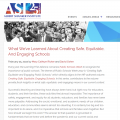
The instructional environment refers to the instructional, behavioral, and personal aspects of the classroom experience.
An extensive amount of research has linked positive academic environments to higher student achievement and graduation rates.
A positive academic environment is characterized by high quality instruction, peers and staff who support achievement-oriented behavior and serve as positive role models, high academic expectations, and institutional academic supports for students. High levels of teacher satisfaction, a sense of collective responsibility among staff for promoting academic achievement, and the availability of teaching materials also characterize a positive academic environment.
Teachers and school administrators who connect to students’ context and reality, cultivate a student culture supportive of academic achievement, and provide students with the necessary supports through culturally responsive practices and differentiated learning can expect positive student outcomes. Opportunities for students to lead and explore topics of their interest paired with effective teaching techniques allow students develop the academic knowledge and skills they need.
When classrooms are mismanaged, behavioral disruptions among a few students may interfere with learning for an entire class. Although the school-wide disciplinary environment plays an important role, strategies for building connections and belonging are key to laying the foundation for a strong academic environment. Classroom management that is trauma-informed and integrated with SEL priorities key principles like trustworthiness and transparency, staff-student relationships, peer support, and collaboration.
Dunbar, C. (2004). Best Practices in Classroom Management. Michigan State University. Retrieved from: https://www.msu.edu/~dunbarc/dunbar3.pdf.
Cipriano, C., Ha, C., Wood, M., Sehgal, K., Ahmad, E., & McCarthy, M. F. (2024). A systematic review and meta-analysis of the effects of universal school-based SEL programs in the United States: Considerations for marginalized students. Social and Emotional Learning: Research, Practice, and Policy, 100029. https://doi.org/10.1016/j.sel.2024.100029
Oliver, M. & Reschly, J. (2007). Effective Classroom Management: Teacher Preparation and Professional Development. Washington: Vanderbilt University. Retrieved from: http://files.eric.ed.gov/fulltext/ED543769.pdf
Substance Abuse and Mental Health Services Administration. SAMHSA’s Concept of Trauma and Guidance for a Trauma-Informed Approach. HHS Publication No. (SMA) 14-4884. Rockville, MD: Substance Abuse and Mental Health Services Administration, 2014.
Suprabha, K., and Subramonian, G. (2021). Blended Learning Instructional Strategy Interventions for Higher Secondary School Students: A Focus on Social Skills. i-manager's Journal of Educational Technology, 17(4), 55-64. https://doi.org/10.26634/jet.17.4.17669

